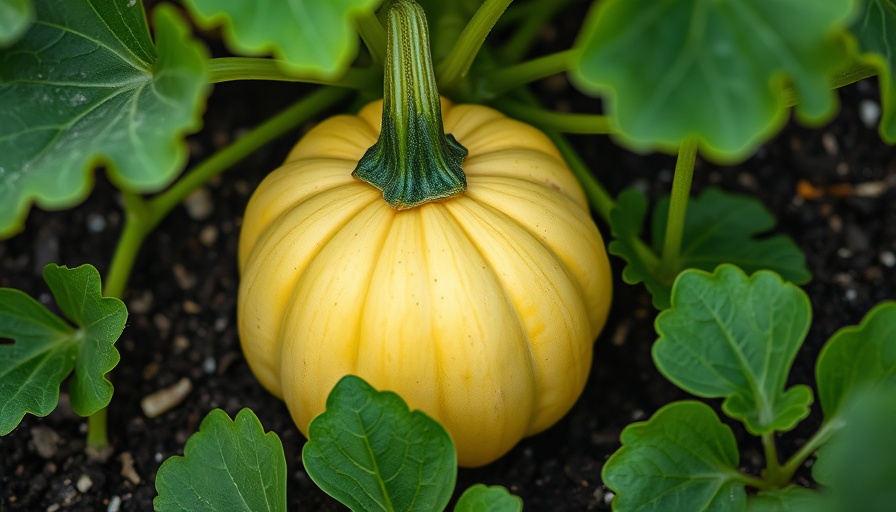
Understanding Butternut Squash: A Gardener's Favorite
For those diving into the world of gardening, planting butternut squash is often a rewarding endeavor. This winter squash, known for its sweet, nutty flavor and creamy texture, is not only a staple in comfort food recipes but also packs a significant nutritional punch. With 50% of the recommended daily allowance of vitamin A in just a half-cup serving, butternut squash is a healthy addition to your diet, offering nutrients such as potassium, fiber, and vitamin C. It’s also versatile enough to be used in salads, soups, and even eaten raw!
The Warm-Weather Crop: Planting Timing is Key
Though classified as a winter squash, butternut squash is actually a warm-season crop, meaning it thrives in temperatures above 60°F. To ensure a successful harvest, it’s essential to calculate your planting timeline accurately. Start by identifying your last frost date in spring and your first frost date in fall. These dates will guide you in determining when to sow your seeds.
The growth period for butternut squash can vary significantly, typically requiring anywhere from 75 to 100 days to reach maturity. This flexibility means that gardeners in warmer climates can successfully grow later-maturing varieties, while those in cooler regions should stick to quicker varieties. Understanding your local climate and timing your planting accordingly can lead to a fruitful harvest.
Calculating the Best Planting Date
To calculate the most effective dates for planting your butternut squash, start by counting the number of days to maturity for your chosen variety. Then, use your local frost dates:
- Count forward from the last frost date by the number of days to maturity to determine the latest planting date.
- Count backward from the first frost date by the same number of days to find the earliest possible planting date.
This range will provide a comfortable timeframe for planting your butternut squash seeds, optimizing the chances for pollination and growth.
Two Effective Planting Methods
Once you’ve established the right planting window, consider how you will plant your butternut squash. Here are two established methods:
Direct-Seeding in the Garden
This method is often the most successful, as it allows the seeds to grow in their final environment without the stress of transplantation. Direct-seeding involves planting seeds straight into the garden bed, ideally after the last frost date, when soil temperatures are warm.
Transplanting Seedlings
Another approach is to start your seeds indoors and transplant them once they’ve developed a few true leaves. This technique may provide a head start on the growing season, but keep in mind that squash roots are sensitive. Ensure minimal disturbance when transplanting to avoid shock.
Caring for Your Butternut Squash Plants
Regardless of your planting choice, butternut squash plants thrive in full sunlight and well-drained soil. They require consistent watering, especially during dry spells, but avoid over-watering as this can lead to root rot. Additionally, consider introducing nearby plants that attract pollinators, which are vital for the fertilization of the male and female flowers that produce the squash.
Harvesting Your Butternut Squash
When the vines begin to dry out and the skin of the squash hardens, it's generally a sign that it’s time to harvest. Use a sharp knife to cut the squash from the vine, leaving a few inches of stem attached to each fruit. Properly cured, butternut squash can last several months in a cool, dark place—perfect for enjoying in winter meals!
Why You Should Consider Growing Butternut Squash
With its delicious taste, nutritional benefits, and diverse culinary uses, growing butternut squash can enhance your home garden. It not only provides quality food but also adds an appealing visual element to your outdoor space. Plus, the satisfaction that comes from harvesting your own produce is unmatched.
Remember, whether you’re an experienced gardener or just starting out, patience and planning are key to a successful harvest. By understanding when and how to plant, you’re setting yourself up to enjoy the fruits of your labor all season long.
If you’re inspired to start your gardening journey or improve your existing garden, consider transforming your outdoor space. Take action today and begin planning your planting strategy for a bumper crop of butternut squash!
 Add Row
Add Row  Add
Add 


 Add Row
Add Row  Add
Add 

Write A Comment